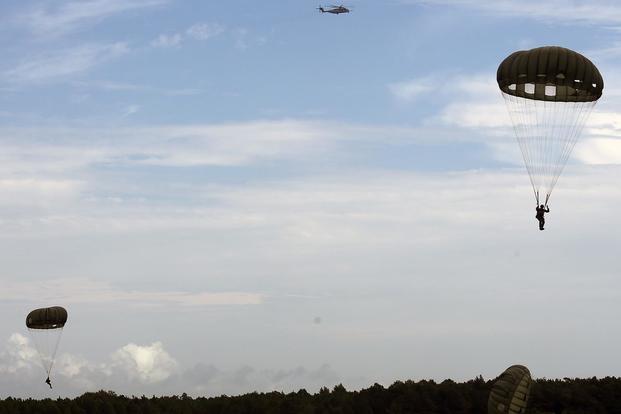Lawmakers are calling on the Marine Corps to evaluate what its reconnaissance and special operations communities really need before investing in a new parachute.
A provision in the conference version of the 2018 National Defense Authorization Act prohibits the service from fully investing in the enhanced multi-mission parachute system it wants until the secretary of the Navy submits a report evaluating whether other systems, such as the Corps' legacy multi-mission parachute, or the Army's new RA-1 system, would meet current mission requirements.
Cost-saving efforts like this are frequently found in the annual budget bill. Last year, lawmakers passed provisions that would keep the military from investing in new camouflage patterns without informing Congress and that slow-rolled the debut of the Navy's new unisex dress cover.
But the Corps' resident parachute expert told Military.com there's a reason the service has special parachute requirements.
Master Sgt. Mikel Latham, ground reconnaissance subject matter expert and parachute proponent for the Marine Corps, said contracting is underway for the enhanced multi-mission parachute, which is set to replace the legacy system after roughly a decade and a half of service life.
Contracting documents show the Marine Corps wants up to 1,200 of these parachutes, along with accessories including harnesses for working dogs and parachutist oxygen systems. While documents detail a range of specifications, Latham said a key feature is a drogue that serves to further slow descent in freefall.
This is a requirement specific to the Marines, who deploy aboard ships for a variety of amphibious missions and may not spend as much time on parachute training during deployments.
"Our recon teams are on the ships potentially for a long time," he said. "And they don't have the opportunity to maintain proficiency in that one skill. And our parachute kind of mitigates that risk. I hesitate to say it's safer, but it mitigates the risk of a guy who hasn't been able to maintain his currency and keep his jumps up."
It's easy to understand why Congress would not want to pay for different parachute systems for relatively small communities in the various services.
Last year, the Army inked a $99 million contract with Airborne Systems North America for the RA-1 Advanced Ram parachute to replace its MC-4 legacy system. That system does not include a drogue configuration.
"From our vehicles to our aircraft, we have a specific way of operating as a Marine Corps, and that's why our performance parameters are the way they are," Latham said. "If, for example, the other existing systems met that, that would be an easy adoption, but currently they don't meet all those parameters."
It's not the first time Congress has questioned a decision by leaders in the Army and Marine Corps to use different equipment for similar missions.
Last year's defense budget bill also contained a query from lawmakers about why the two services were still using different 5.56mm ammunition for their M4 and M16A4 rifles.
Marine Corps officials have more recently said the service is working to adopt the Army's round.
-- Hope Hodge Seck can be reached at hope.seck@military.com. Follow her on Twitter at @HopeSeck.








